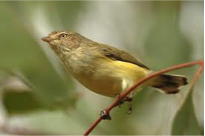- « Back to Catalog
-
Weebill
- Smicrornis brevirostris
-

-
The Weebill’s common name comes from the short, stubby, pale beak. The eye is pale cream, and there is a pale line above the eye. Weebills are dull grey-brown on the head and olive-brown on the back, and the underparts are buff to yellow. Both sexes are similar in colouration, and young birds can be separated from the adults by their greyer eye. May be seen hovering on the outer edges of the canopy.
- http://www.graemechapman.com.au/library/viewphotos.php?c=553
- http://www.graemechapman.com.au/library/sounds.php?c=553&p=131
- « Back to Catalog
-
Weebill
-

-
The Weebill’s common name comes from the short, stubby, pale beak. The eye is pale cream, and there is a pale line above the eye. Weebills are dull grey-brown on the head and olive-brown on the back, and the underparts are buff to yellow. Both sexes are similar in colouration, and young birds can be separated from the adults by their greyer eye. May be seen hovering on the outer edges of the canopy.
- Smicrornis brevirostris
- 465
- 8-9cm
- http://www.graemechapman.com.au/library/sounds.php?c=553&p=131
- http://www.graemechapman.com.au/library/viewphotos.php?c=553
- http://birdlife.org.au/bird-profile/weebill
